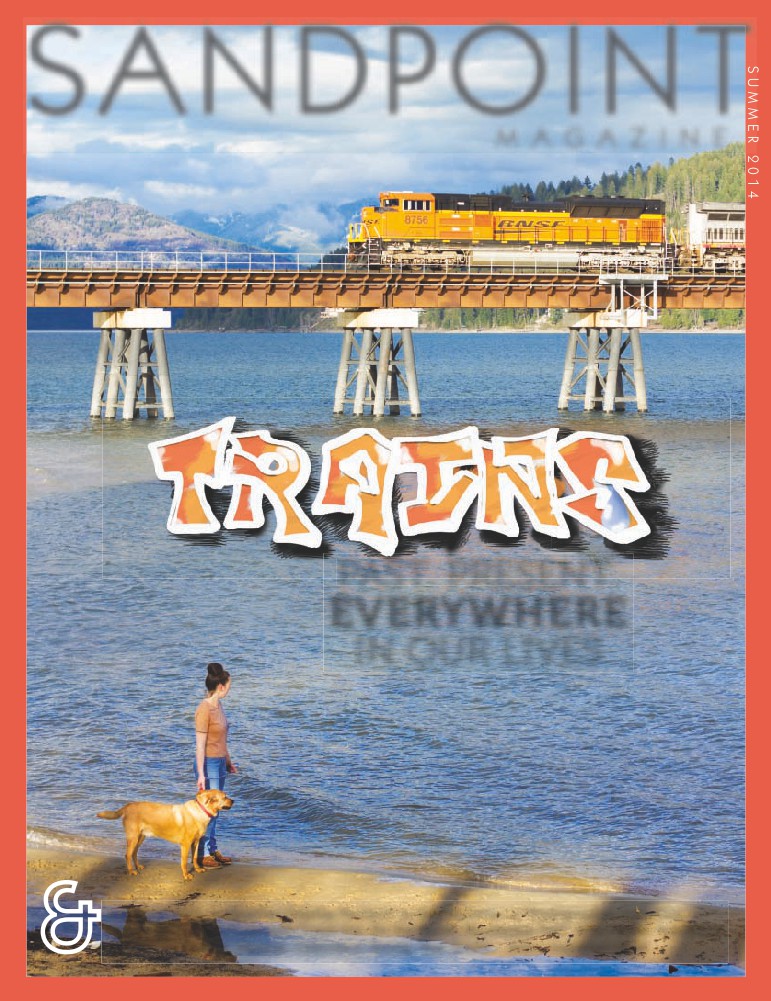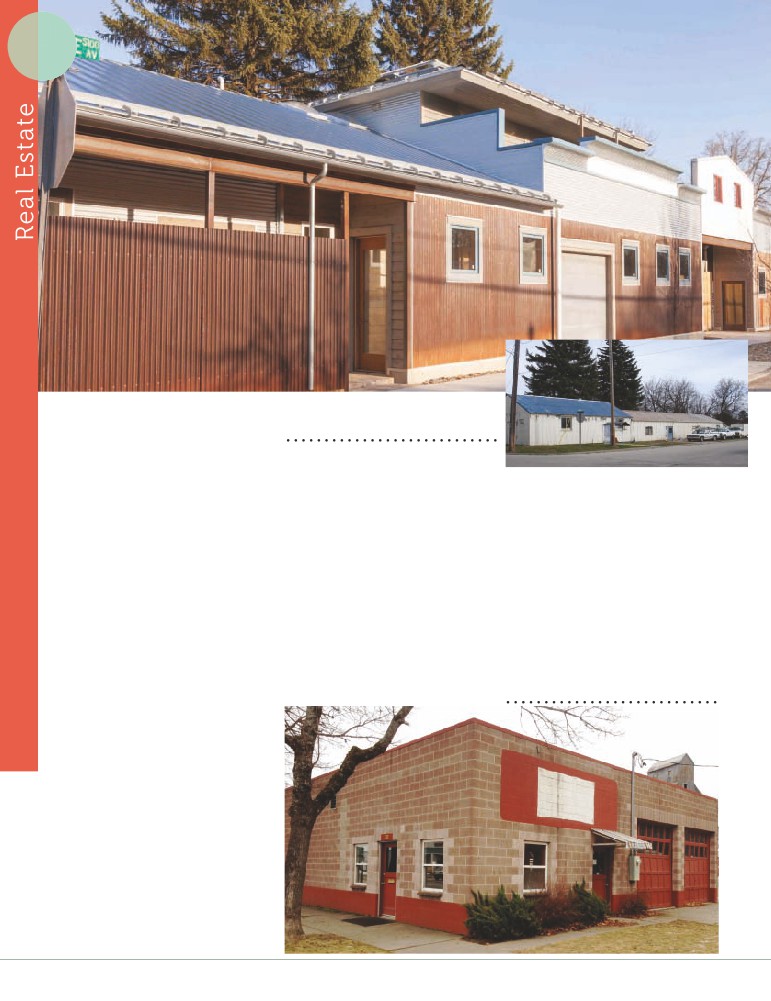

|
| PREVIOUS |
RECYCLED BUILDINGS |
 SANDPOINT
M A G A Z I N E
PAST. PRESENT.
EVERYWHERE
IN OUR LIVES
Interview with Songwriter Charley Packard, In the Footsteps of Photographer Dorothea
Lange, End of the Coldwater Creek Era, On the Pacific Northwest Trail, Artist Karen Robinson,
Ethan’s Treehouse, Alpacas, Calendars, Dining, Real Estate ... and a trainload more
&
 Recycled buildings
Labors of love add up to good stewardship
BY SANDY COMPTON
oss Hall once climbed the J.C.
Penney building at First and
Cedar - now Snow River - and
R
made a picture of downtown Sandpoint.
It was 1955 and (maybe) before a Fourth
Inset, Sandpoint, as Ross Hall captured it in 1955, and the modern-day, reclaimed corner of Oak
of July parade - there are no flags to
and Sixth, above, featuring the Heartwood Center. PHOTO BY DOUG FLUCKIGER
be seen. Nonetheless, Sandpoint’s
entire population appears to be on the
Kubiak turned the building into an art
In the old CO-OP Farm Store at
sidewalks. I find myself looking for fam-
studio and a home for Sandpoint Arts
the corner of Sixth and Church, once
ily in the clumps of folks visiting in
Alliance for a time.
stocked with barbed wire, fence posts,
front of businesses, a localized version
East on Oak is Foster’s Crossing, a
corral panels and watering troughs,
of “Where’s Waldo?” Knowing Ross
railroad warehouse rescued years ago
Evans Brothers Coffee has found a
Hall, maybe he invited his friends and
by Dick and Betsy Foster and turned
home. In the elevator east of Evans
acquaintances - which was the populace
into Sandpoint’s first antique mall. On
Brothers, rolled oats, chicken scratch,
of Sandpoint - to come stand around
the east side of Fifth, Domino’s makes
horse pellets, and bales of alfalfa once
while he made a couple of exposures.
pizza in the former Alpine Motors sales
waited in dark, dusty rooms for a ride to
“You can all go home now! Thanks.”
room - which explains the big windows.
the farm and farmers brought grain to be
Comparing this picture to now, I find
The attached Quonset-hut shop building
stored and sifted into trucks or rail cars
that nearly all the buildings are original,
once contained Alpine’s service area but
for a ride to market. Now, the Sandpoint
but most of them have been repur-
now houses an auto detailing shop.
Climbing Gym occupies part of the
posed. The only businesses on First
Kitty-corner across Fifth, the Army
building. But not the tall part.
from earlier times are Larson’s Clothing
Surplus Store was Sandpoint Ice and
Continuing north along Sixth toward
and the Panida Theater. If you look
Fuel for decades, even after they quit
the point of beginning, we come to a
_
west on Cedar, the only survivors are
selling ice. To the south, the Pie Hut
cross-street dichotomy where two dispa-
Connie’s Café and the Tam O’Shanter,
occupies what were offices for Cenex
rate buildings are being “saved,” one of
E
also known as the Tervan.
CO-OP Gas and Supply, renamed the
humble beginnings and the other with a
Sandpoint has become a recycled city.
CO-OP Country Store and moved to
more glorious past.
Ponderay in 1996. The CO-OP, where a
kid could get lost in long aisles of every
A recycled block
Shibusa Studios: An architec-
sort of hardware, smelled of new tires
tural lump reborn
In fact, the corner of Sixth and Oak
and petroleum and occupied the space
could be recycle central. Face north in
that is now Marketplace Antiques.
At the southeast corner - 525 Oak,
that intersection and rotate clockwise.
Bizarre Bazaar is in the former CO-OP
an address a numerologist could love -
You encounter first Redtail Gallery,
Auto Center, where once tires were sold
the nondescript red-and-gray cube that
formerly the Episcopal Church. Mark
and oil was changed.
housed Darigold is being transformed
SUMMER 2014
SANDPOINT MAGAZINE
107
 R
E
Before and after: Pine and Florence. PHOTO ABOVE BY
by artist Kevin Watson into Shibusa
DOUG FLUCKIGER. PHOTO AT RIGHT, COURTESY CHRIS HECHT
Studios. Shibusa is a Japanese aes-
thetic featuring “an enriched, subdued
appearance or experience of intrinsi-
Saving the corner: The
cally fine quality with economy of form,
Heartwood Center
line and effort.” Watson and his build-
Oleson’s work outside is elegant and
ing mate, interior designer, painter and
Across the street from Shibusa is the
effective. “Karen not only designed the
sculptor Dion Williams, are enamored of
Heartwood Center, formerly known as St.
landscaping, she built it,” Millard said.
the shibusa style, evident in the display
Joseph’s Catholic Church, and the inspi-
“It’s all native plants that will take a lot of
room and Williams’ office. “We share
ration of Susie and Mark Kubiak.
water or a little. And we solved the storm
the same sense of design,” Watson
“It started with wanting to save the
water management in an ecological way.”
said, “abstract, simple, clean lines. Our
integrity of this corner,” said Susie. “We
The building is “green” inside,
art will show well together.”
wanted to restore the building as well as
too, with LED or LE fluorescent lights
But behind door No. 2, Watson’s per-
save the trees and preserve the park-like
throughout and a zoned heat and cool
sonal studio is forming, featuring dark
setting.” With the help of architect Bruce
system designed to maximize energy
purple, Moroccan décor accented by
Millard, landscape architect Karen Oleson
conservation.
canvas-covered walls, a creative solu-
and general contractor Jim Dustman, the
From Darigold to Shibusa, it’s a long step to
tion to what was once a walk-in cooler
Kubiaks have achieved their goal.
Kevin Watson’s vision. PHOTO COURTESY KEVIN WATSON
(the evaporators are still in place).
“It will look like an upscale wall tent,”
Watson said.
The building itself, built as a dairy
warehouse with loading docks, indus-
trial roll-up doors and three walk-in
coolers, is an architectural lump.
Cement block walls support two mas-
sive steel girders salvaged from a
railroad bridge holding up a flat roof. It
could have been designed as a jail.
Which begs the question, “Why this
building, Kevin?”
“I walked by this building on my way
to work for eight years,” he said, “and the
first time I saw it, I wanted it.” Now he’s
got it and is following his vision.
108
SANDPOINT MAGAZINE
SUMMER 2014
 Wildflower Day Spa leases space from Chris
said, “is that it should feel like you’re
Sweating the details: Pine and
Hecht for its new location. PHOTOS BY DOUG FLUCKIGER
living in the country.”
Florence
The church itself has been restored
Chris Hecht, whose recycling project
A view to a school: Northside
to its original configuration. Gone with
is at the corner of Pine and Florence, has
School Bed and Breakfast
the Stations of the Cross and the stained
taken another lump of a structure - the
glass windows is the balcony that was
former school administration headquar-
Our last example of a building saved
added to the north end of the nave. At
ters and maintenance shop - and turned
is not in Sandpoint, but on a hill above
the other end, under the brick arch that
it into great architecture.
the Kootenai River in Bonners Ferry:
once rose above the chancel, is a stage
“One reason I bought such a head-
Northside School Bed and Breakfast. I
with professional-grade lighting, a back
ache,” he said, “was the grandfathered
hate to be prejudicial, but the old school
stage dressing room, side curtains and
wood shop.” Hecht has been teaching
transformed is my favorite. Gene and
a large stage front curving into a room
woodworking to Waldorf students for 15
Ruth Perry have created something new -
that will seat 170 theater style.
years. It used to be necessary for them to
and lovely - while holding on to the origi-
The arch and condition of the 1960s
travel to Garfield Bay for classes. “Now,
nal essence of the building that houses it.
add-on at the south end of the building
the kids can walk here.”
Ruth herself went to school in the
were the big challenges. A crack com-
The building is a mixed-use dream:
building, as did her father and aunt. Put
pletely through the arch required special
semi-industrial classroom; garden space;
into service 100 years ago in 1914, the
engineering to repair. Except for that,
living quarters; a sod roof that gathers
school taught generations of kids. In
Millard said, “the original 1908 part was
irrigation water to a cistern; and 1,000
1992, it became a private residence, but it
just fine. But anything added later, we
square feet of commercial space occupied
wasn’t until 2005, when the Perrys bought
had to do a major rebuild.”
by Wildflower Day Spa.
it, that true transformation began.
They have been successful. The for-
“I sweat details,” Hecht said, and they
Gene spent a career in California as
mer parish hall next door is turned into
are everywhere. He used doors saved
an architect. He was tasked with creat-
the Grove Room, meeting space with
from the Cedar Street Bridge, timbers left
ing what Ruth envisioned. “In my mind,”
lots of light from big windows and a
over from the bypass construction and
Ruth said, “I divided up the classrooms,”
small serving kitchen for catered events.
much metal siding, some salvaged, some
and where there were four big classrooms
The connection between buildings,
not. Hecht distressed new siding at the
and a principal’s office, now are a dining
designed by Millard, is graceful and airy
street level simply because he didn’t want
room large enough to seat a full house;
and gives the impression of being out-
it to be reflective and distract drivers. One
nine themed rooms, each decorated dif-
side. In the real outside are touches that
of the most unique uses of salvaged mate-
ferently and each beautiful in its own
add beauty and functionality simultane-
rials hangs from the eaves: snow-stops
right; and the private suite the Perrys live
ously, like the rock slab “waterfall” that
made of old band saws. A genius mount-
in. Cloakrooms that divided the class-
slows runoff from the Grove Room roof
ing system, which Hecht came up with,
rooms are now hallways. Instead of three
_
and channels it into the landscape.
serves without penetrating the roof.
bathrooms (which were in the basement)
The project has taken over two
It cost thousands of dollars to bury the
there are 15.
E
years and included disheartening
power lines servicing the building, but “I
“We didn’t intend to create a B&B in
moments - like discovering the crack
didn’t ever want to see that over here,” he
Idaho,” said Ruth, “but we were looking
in the arch - but Susie Kubiak is
said, pointing across Pine at trees topped
for one to buy in California. We came
completely happy they have seen it
or oddly pruned to provide relief from
home to visit and saw this for sale, and
through to completion. “For a long
overhead lines.
said, ‘This would make a great bed and
time, I’ve wanted to restore an old
A building tour reveals it to be a
breakfast.’ ”
building,” she said. “That’s what
compilation of structures tied together
And it does, with preserved touches
towns should be doing instead of
by the metal theme and the idea of mul-
that hearken back to the building’s past:
building out, especially with their
tiple use, “new urbanism,” Hecht calls
bird’s-eye maple floors on the main level;
great architecture.”
it. “My thing about living in town,” he
vertical grain Douglas fir stair treads 14
SUMMER 2014
SANDPOINT MAGAZINE
109
|
|
|
Copyright © 2002-today Bruce Eugene Millard, Studio of Sustainable Design. Website by www.gentleharvest.org |